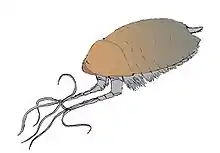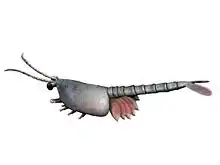1912 in paleontology
Paleontology or palaeontology is the study of prehistoric life forms on Earth through the examination of plant and animal fossils.[1] This includes the study of body fossils, tracks (ichnites), burrows, cast-off parts, fossilised feces (coprolites), palynomorphs and chemical residues. Because humans have encountered fossils for millennia, paleontology has a long history both before and after becoming formalized as a science. This article records significant discoveries and events related to paleontology that occurred or were published in the year 1912.
| |||
|---|---|---|---|
Expeditions, field work, and fossil discoveries
- William Edmund Cutler first began collecting fossils, choosing the mouth of Kneehills Creek in Alberta as a prospecting site. According to paleontologist Darren Tanke, Cutler was motivated by "commercial gain".[2]
- Charles H. Sternberg and his sons began working under a contract with the Geological Survey of Canada, which at the time was responsible for maintaining the National Museum of Canada. Lawrence Lambe occupied a supervisory position in the project. The Sternbergs were in competition with Barnum Brown of the American Museum of Natural History through a period that came to be known as the Great Canadian Dinosaur Rush.
Institutions and organizations
Natural history museums
- The Calgary Public Museum of Alberta, Canada moved to occupy a single floor of the city's Memorial Park Library Building.[2]
Scientific advances
Invertebrate paleozoology
| Name | Status | Authors | Discovery year | Age | Location | Notes | Images |
|---|---|---|---|---|---|---|---|
| Burgessia | Valid | Walcott | 1912 | Cambrian | |||
| Leanchoilia | Valid | Walcott | 1912 | Cambrian |
|
 | |
| Waptia | Valid | Walcott | 1912 | Cambrian |
|
 | |
| Yohoia | Valid | Walcott | 1912 | Cambrian |  |
Vertebrate paleozoology
| Name | Status | Authors | Age | Location | Notes | Images |
|---|---|---|---|---|---|---|
| Alopecorhinus | Valid | 262 million years ago | ||||
| Valid | 257 million years ago | |||||
| Emydops | Valid | Broom | 257 million years ago | |||
| Galeops | Synonym of Emydops. | Broom | ||||
| Ictidopsis | Synonym of Thrinaxodon. | |||||
| Taurops | Valid | Broom | ||||
| Tritheledon | Valid | Broom | 194 million years ago |
Data courtesy of George Olshevsky's dinosaur genera list.[3]
| Name | Status | Authors | Location | Notes | Images |
|---|---|---|---|---|---|
| Saurolophus[4] | Valid taxon | a Hadrosaur with a Horn-like crest on its head. |
Law and politics
Ethics and practice
People
Awards and recognition
Popular culture
Literature
- The Lost World by Sir Arthur Conan Doyle was published. This novel was the first major fictional portrayal of dinosaurs in the 20th century. It was also the first work of fiction to depict dinosaurs as surviving somewhere in a remote wilderness refuge. Conan Doyle depicted the novel's dinosaurs as cold blooded and stupid. This accurately reflected the scientific thinking of the period, but is now obsolete. Paleontologist William A. S. Sarjeant has characterized Conan Doyle's dinosaurs as otherwise "excellently described".Conan Doyle also incorrectly accepted the prevailing scientific consensus of the period that pterosaurs were poor fliers who depended on gliding to travel. Nevertheless, Sarjeant also noted that while Conan Doyle underestimated pterosaur flying abilities, he anticipated the later scientific conclusion that they were social animals.
See also
References
- Gini-Newman, Garfield; Graham, Elizabeth (2001). Echoes from the past: world history to the 16th century. Toronto: McGraw-Hill Ryerson Ltd. ISBN 9780070887398. OCLC 46769716.
- D. H. Tanke. 2010. Lost in plain sight: rediscovery of William E. Cutler's missing Eoceratops. In M. J. Ryan, B. J. Chinnery-Allgeier, D. A. Eberth (eds.), New Perspectives on Horned Dinosaurs: The Royal Tyrrell Museum Ceratopsian Symposium. Indiana University Press, Bloomington 541-550.
- Olshevsky, George. "Dinogeorge's Dinosaur Genera List". Retrieved 2008-08-07.
- Brown, B. 1912. A crested dinosaur from the Edmonton Cretaceous. Bull. Am. Mus. Nat. Hist. 31: pp. 131-136.
This article is issued from Wikipedia. The text is licensed under Creative Commons - Attribution - Sharealike. Additional terms may apply for the media files.